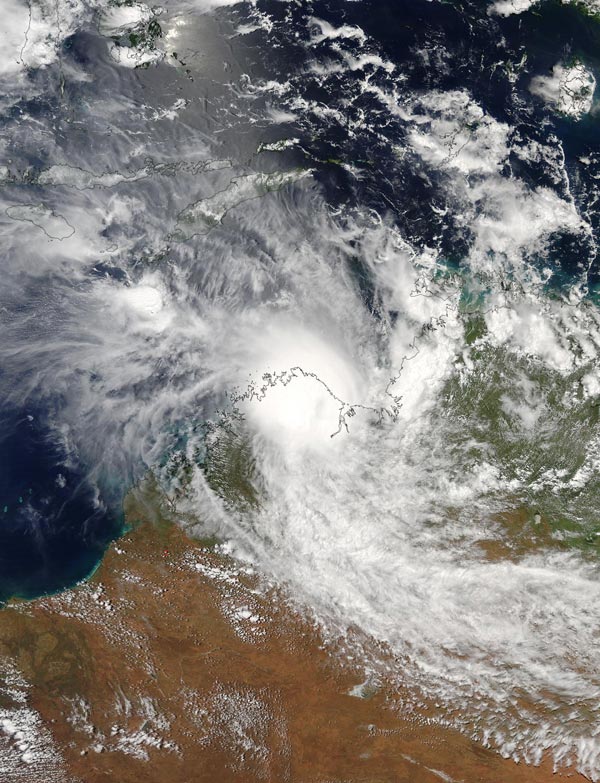NASA takes a double-look at Tropical Cyclone Blanche

NASA's Aqua satellite captured this visible image of Tropical Cyclone Blanche over northern Australia on Mar. 6 at 05:15 UTC (12:15 a.m. EST). Credits: NASA Goddard MODIS Rapid Response Team
Top End is the northernmost geographical region of Australia's Northern Territory.
The Atmospheric Infrared Sounder or AIRS instrument aboard NASA's Aqua satellite looked at Tropical Cyclone Blanche in infrared light while the Moderate Resolution Imaging Spectroradiometer or MODIS instrument aboard the satellite captured a visible image of the storm. Blanche is located over Australia's Top End.
The AIRS image was taken on Mar. 6 at 05:11 UTC (12:11 a.m. EST) and showed some cloud top temperatures of thunderstorms within Blanche were as cold as minus 63 degrees Fahrenheit (minus 53 degrees Celsius).
Those powerful storms surrounded Blanche's low-level center of circulation. NASA research has shown the storms with cloud tops that cold have the potential to generate heavy rainfall.
Four minutes after AIRS analyzed the storm the MODIS instrument provided a visible picture of Tropical Cyclone Blanche at 05:15 UTC (12:15 a.m. EST). The MODIS image showed that most of Blanche had already moved over land and its northeastern quadrant stretched into the Joseph Bonaparte Gulf.
On March 6 at 1500 UTC (10 a.m. EST), Tropical Cyclone Blanche made landfall on the Kimberley Coast and is dissipating. It was located about 182 nautical miles west-southwest of Darwin, Australia. It was centered near 16.0 degrees south latitude and 127.2 degrees east longitude.
The Joint Typhoon Warning Center's final warning at that time noted that Blanche had maximum sustained winds near 34.5 mph (30 knots/55.5 kph) and was a depression. The storm was moving to the south-southwest at 12.6 mph (11 knots/20.3 kph) and further inland in Top End.
The Australian Bureau of Meteorology noted on March 6 (EDT) to “Expect scattered showers and storms to continue over western Top End with falls of 30 to 80 mm. Heavier rainfall may extend to the Gregory District on Tuesday. Some roads may remain impassable for some time until conditions improve.”
###
See http://www.
Media Contact
All latest news from the category: Earth Sciences
Earth Sciences (also referred to as Geosciences), which deals with basic issues surrounding our planet, plays a vital role in the area of energy and raw materials supply.
Earth Sciences comprises subjects such as geology, geography, geological informatics, paleontology, mineralogy, petrography, crystallography, geophysics, geodesy, glaciology, cartography, photogrammetry, meteorology and seismology, early-warning systems, earthquake research and polar research.
Newest articles

Properties of new materials for microchips
… can now be measured well. Reseachers of Delft University of Technology demonstrated measuring performance properties of ultrathin silicon membranes. Making ever smaller and more powerful chips requires new ultrathin…

Floating solar’s potential
… to support sustainable development by addressing climate, water, and energy goals holistically. A new study published this week in Nature Energy raises the potential for floating solar photovoltaics (FPV)…

Skyrmions move at record speeds
… a step towards the computing of the future. An international research team led by scientists from the CNRS1 has discovered that the magnetic nanobubbles2 known as skyrmions can be…




















